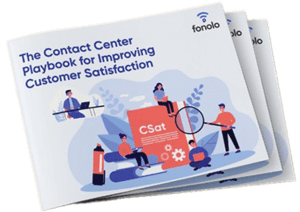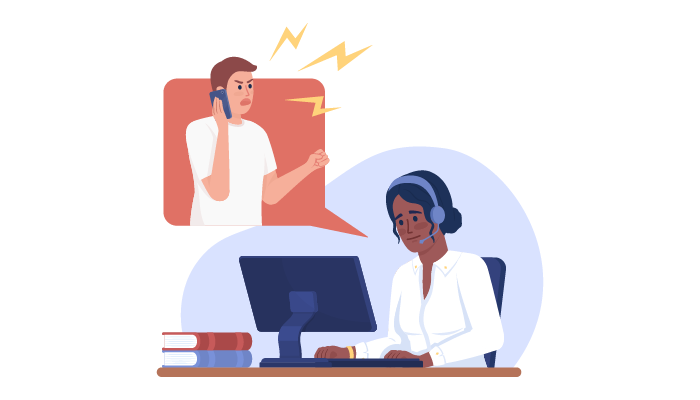Active listening is an essential skill for contact center agents for one very good reason: customers want to be heard. Come to think of it, everybody wants to be heard!
Of course, customers want a lot of other things, too. They want answers to questions, speedy service, the opportunity to solve their own problems quickly using self-service, and the option to talk to an agent when the going gets tough. (Call-backs are great for bridging the gap between self-service and live calls, by the way.) They don’t like repeating themselves, and they definitely want to know you are listening to them. This brings us back to our topic for today: active listening matters!
Have you noticed that people compliment others on their great listening, as though it’s an innate gift or a personality trait? It’s nice to be told: “You are a great listener!” But active listening is not an ability some people are just born with. It’s a transferrable skill that can be practiced, taught, and learned. In this blog post, we’ll take a look at the elements of active listening and give specific examples of how contact center agents can use active listening skills to provide exceptional customer service in the contact center. Let’s go!
5 Ways to Become an Active Listener
There are several key elements of active listening. They all help ensure that you really hear and understand the person you’re talking to. They also demonstrate to the person on the line that you are listening attentively to what they have to say.
1. Pay Attention to Non-Verbal Cues
Paying attention is not as simple as it sounds, when as much at 55% of the information people share is non-verbal. On a phone call, non-verbal communication includes the tone, the pauses, the volume level, and the feeling you get from the person you’re talking to. There’s a lot of information being shared that never gets spoken.
To make sure you pick up on these non-verbal cues, avoid multitasking – dedicate your ears and your focus to your customer. When they’re done speaking, summarize key points and ask questions to ensure you understand correctly (more on this below). Your attention to these nuances is the secret sauce to customer satisfaction. Practice these skills to elevate your phone prowess and make every call count!
Scenario:
A customer calls to request service on a product that is malfunctioning. They are speaking in a clipped fashion, with many pauses and a frustrated tone. The non-verbal cues in this call tell you that the customer is fed up. The agent should reply with a calm and empathetic tone to demonstrate that they are listening, they understand, and they care. This will help put your customer at ease and make the call go more smoothly.
2. Resist the Urge to Interrupt
It’s no surprise that 70% of customers get frustrated when they’re interrupted while speaking. Your agents will likely have questions when your customer is explaining their problem but should resist the urge to jump in and instead absorb the details they are sharing. Active listening means giving your customer the spotlight. They’ll feel heard and valued, and your customer satisfaction score will go through the roof! Agents should take mental notes, offer appropriate supportive comments, and let the customer take the lead. Don’t worry; other active listening steps involve summarizing their statements and asking relevant questions to make sure you’ve got the whole picture.
Scenario:
A customer is trying to book an airline ticket but has questions about the luggage allowances and calls the airline service center with several questions. They begin the call by describing their luggage and explaining that they know regulations have changed in recent years. The agent knows that the answers to questions about what is allowed as carry-on luggage are simple, but instead of interrupting, they listen attentively, acknowledging their comments by saying, “I see” or “I understand.” When the customer has finished speaking, the agent responds with clarifying questions and a summary to ensure you’ve understood them correctly. The transaction is resolved quickly, in a friendly, encouraging fashion that leaves customers feeling positive about the airline they’ve chosen.
3. Confirm Your Understanding by Summarizing What You’ve Heard
By paraphrasing your customer’s concerns and repeating a concise summary in a friendly way (“Sounds like you are saying…”) agents make sure they have a good understanding of the caller’s problem. Asking follow-up questions to gather more information signals to the customer that they have been heard and gives the agent a chance to fill in any gaps in the story. This is a win-win approach where the customer feels heard and understood, and the agent gets a clear understanding of the problem before offering solutions.
Scenario:
A customer calls with questions about delivery arrangements for an online purchase. They are concerned because they will be leaving on holiday soon and want to ensure their delivery arrives before they depart. The agent summarizes what the customer has told them, confirms the delivery is scheduled to before their departure, and repeats the tracking number. The agent personalizes the conversation by wishing the customer a happy holiday and empathizes with the desire to ensure the safe delivery of their order before they depart. These interactions leave customers saying: “They get me!” Today’s customer service is not just about solving problems. It’s about relationship building and nurturing customer loyalty.
4. Listen Without Judgment
When a customer is upset, it’s easy to react emotionally to the situation, but customer service professionals are trained to diffuse tense situations and know not to take things personally. Active listening is a helpful tool in this situation, too. It requires the agent to listen attentively and withhold judgment, letting the customer tell their complete story without interruption or disagreement. After the customer has explained their problem, an agent could reflect what has been said, paraphrasing back to the customer empathetically by saying: “What I’m hearing is…” or “Sounds like you are saying…”
Scenario:
An angry customer calls after receiving an item that is the wrong size for their needs. They received the item they ordered, but they’re angry because they feel the sizing was misleading. The agent knows the full dimensions are listed on the website but does not interrupt the caller to point this out. Instead, they listen attentively to the caller, acknowledging their frustration. They reflect the customer’s concerns back to them and empathize with the customer’s disappointment. The call is resolved quickly, as a new item is chosen, and the customer’s angry feelings have been neutralized by the excellent customer service they’ve received. The business has won another chance with this customer.
5. Respond Appropriately and Ask Questions
After listening openly and attentively, then summarizing the caller’s information to ensure they’ve understood, the agent can respond with further questions to clarify the customer’s problem. It’s helpful to empathize first, to let the customer know the agent not only understands their problem but is invested in their well-being and is motivated to find a solution. This is the time to politely fill in any gaps in information, gather more facts, and also demonstrate that you have the tools needed to find an answer.
Scenario:
An insurance customer calls with questions about their healthcare coverage. They have a new prescription and have been told by their pharmacist that it is not covered under their policy. They are calling for more information and to clarify. After listening to the customer’s issue, the agent politely asks follow-up questions about the customer’s policy, their prescription, and any steps they have taken to fill the prescription. The agent empathizes with the customer’s situation and carefully explains the details of the policy so the customer fully understands the best way to make use of the available coverage. The customer leaves the call with their questions answered, a better understanding of their policy, and a positive impression of their insurance carrier.

The Contact Center Playbook for Improving Customer Satisfaction
In this handy playbook, contact center leaders will learn the ins and outs of improving customer satisfaction.

